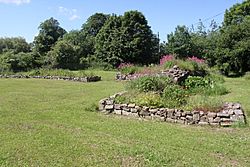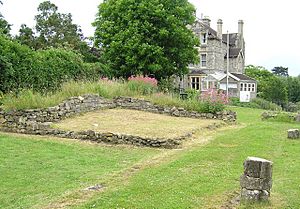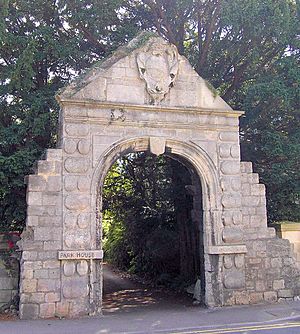Keynsham Abbey facts for kids

Ruins of Keynsham Abbey
|
|
| Monastery information | |
|---|---|
| Full name | The house of the Canons of the Order of St. Austin and St. Victor |
| Order | Augustinian |
| Established | c. 1170 |
| Disestablished | 1539 |
| People | |
| Founder(s) | William, Earl of Gloucester |
| Site | |
| Location | Keynsham, Somerset, England |
| Coordinates | 51°25′02″N 2°29′46″W / 51.4172°N 2.4961°W |
Keynsham Abbey was a large religious building in Keynsham, Somerset, England. It was founded around 1166 by William, Earl of Gloucester. The abbey was home to a group of Augustinian canons regular, who were like priests living together in a monastery. It operated for many centuries until it was closed down in 1539 during the dissolution of the monasteries.
Contents
Where Keynsham Abbey Stood
Keynsham Abbey was built on the south side of the River Avon. It was located where the River Avon meets the River Chew. This area is known as the Keynsham Hams, which is a flat, open plain often flooded by rivers. It has fields, pastures, and meadows, separated by hedges and ditches.
People have lived in this area for a very long time, even before the abbey was built. There was a Roman settlement here in the 4th century, possibly called Trajectus. This settlement was left empty after the Roman soldiers left Britain. The abbey was built close to an old Roman road, which later became the Bath Road. This road connected London with Bath and Bristol. Today, you can see the ruins of the abbey in Keynsham's Memorial Park, near the A4 road and Keynsham railway station.
The Abbey's Story
How Keynsham Abbey Started
There was a religious community in Keynsham even before the abbey, in the 9th and 10th centuries. However, the abbey we know was founded by William Fitz Robert, 2nd Earl of Gloucester. He started it in 1166, the same year his son Robert died. People say he built it because his son asked him to before he passed away.
The abbey was for Augustinian canons regular. These were priests who lived together in a monastic community and did religious work. The canons at Keynsham followed a popular religious group called the School of Saint Victor. Because of this, the leader of the abbey was always called an abbot. The abbey was known as the House of the Canons of Saint Austin and Saint Victor.
When the abbey was founded, it was given a lot of land. This included the entire area known as the manor and the hundred of Keynsham. This huge area covered about 24,520 acres (9,920 hectares). It included many local parishes and their churches, like St. Mary and St. Peter and St. Paul, and several chapels.
The symbol of the abbey featured six golden trumpets on a red background. These symbols came from the de Clares family, who were the Earls of Gloucester.
Growing and Managing the Abbey
In 1276, King Edward I visited the Abbey while traveling between Bath and Bristol. Over time, a town grew up around Keynsham Abbey. In 1307, King Edward II gave the abbey permission to hold a weekly market every Tuesday. They also got permission for a yearly fair during the festival of the Assumption. These rights were confirmed again by King Edward IV in 1461. The Abbey also gained a lot of property in Ireland.
As the years went by, the abbey sometimes had problems with its rules. In 1350, the bishop pointed out that the canons were not properly guarding the abbey's main gate. He worried that church items and treasures could be easily stolen. The canons were also told to keep better records of their money, attend prayers more often, and stop enjoying luxuries like hunting dogs and eating outside the abbey.
In 1353, the bishop visited again and found many things were still not being done properly. The doors were still unguarded, money records were messy, and prayers were often missed. Up to two-thirds of the canons were regularly skipping community meals and playing games. Similar problems came up again in 1450, with the bishop making many of the same complaints about how the abbey was run and kept.
The Abbey's End
In 1534, the Act of Supremacy was passed. This law made Henry VIII the supreme head of the English Church. The last abbot of Keynsham Abbey, John Staunton, along with 14 other religious leaders, agreed to this new law. They promised to be loyal to Henry VIII as the head of the church.
The next year, in 1535, Henry VIII ordered a survey of all church finances. He sent his agent, Richard Layton, to visit monasteries like Keynsham Abbey. Layton's job was to check their money and records. Four years later, on January 28, 1539, two of Henry VIII's officials, John Tregonwell and William Petre, came to the abbey. The abbot and ten monks gave up the abbey, and they all received money or payments to live on.
After the abbey was given up, people started taking it apart over the next 400 years. They used its stones and materials for other buildings. Within two years, the church part of the abbey was being taken down and sold. Records show that a man named Richard Walker was paid to melt the lead from the church roof, the cloister (a covered walkway), and the steeple. Another person bought the church's seven bells.
The entire abbey site was eventually sold to Thomas Bridges. He took down the remaining buildings and built his family home there. In 1559, Bridges even gave leftover stone from the Abbey Church to help repair the bridge and road over the nearby River Avon.
The house built by the Bridges family was torn down in 1776. Later, in the 1800s, builders and people digging for materials continued to take stones from the site. This went on until the early 1900s. Eventually, only small pieces of stone that were not useful or were buried deep remained. In some places, so much material was dug up that they reached the natural rock underneath.
What Happened Later
In the 1960s, there were plans to build a new road, the A4 bypass, right through the abbey site. This would have destroyed what was left of the ruins. So, archaeologists dug up the area before construction began. Among the things they found was a fipple flute, which is an old type of recorder. Today, the remains of Keynsham Abbey are protected as a Grade I listed building and a Scheduled Ancient Monument. This means they are very important historical sites.
Important People Buried Here
- Jasper Tudor, Duke of Bedford died in 1495 and was buried at Keynsham Abbey.
- William Fitz Robert, 2nd Earl of Gloucester, who founded the abbey.
- Robert Fitzwilliam, William's son.




